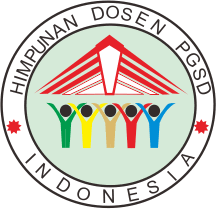Pengaruh model Teaching Personal And Social Responsibility (TPSR) dengan menggunakan teknikal Hand Out olahraga kesehatan terhadap peningkatan tanggung jawab latihan dan aktivitas latihan fisik mahasiswa PGSD
Abstract
This study aimed to analyze the effect of the Teaching Personal and Social Responsibility (TPSR) model combined with a Health Sports Technical Hand Out (THO) on improving training responsibility and physical activity among Primary School Teacher Education (PGSD) students at IPI Garut. A quasi-experimental method with a pretest-posttest control group design was employed. The sample, selected purposively, consisted of two classes: an experimental group receiving the TPSR+THO intervention and a control group without treatment. Instruments included a training responsibility questionnaire and a physical activity observation sheet, both validated and tested for reliability. Data analysis used paired t-tests, gain scores, and independent sample t-tests (α = 0.05). Results showed significant improvements in all variables for the experimental group, with the largest gains in duration (+38.40 minutes; d = 1.142) and training intensity (+41.80 points; d = 2.447). These findings confirm that integrating TPSR and THO effectively fosters responsible character and enhances the quality of students’ physical activity. This model has strong potential for implementation in character-based physical education at the university level.
Keywords
Full Text:
PDFReferences
Craft, L. L., & Perna, F. M. (2004). The benefits of exercise for the clinically depressed. Primary Care Companion to the Journal of Clinical Psychiatry, 6(3), 104–111.
Dyson, B. (2014). Quality physical education: A commentary on effective physical education teaching. Research Quarterly for Exercise and Sport, 85(2), 144–152.
Escartí, A., Gutiérrez, M., Pascual, C., & Llopis, R. (2010). Implementation of the Personal and Social Responsibility Model to Improve Self-Efficacy During Physical Education Classes for Primary School Children. International Journal of Psychology and Psychological Therapy, 10(3), 387–402.
Gould, D., & Carson, S. (2008). Life skills development through sport: Current status and future directions. International Review of Sport and Exercise Psychology, 1(1), 58–78. https://doi.org/10.1080/17509840701834573
Hillman, C. H., Erickson, K. I., & Kramer, A. F. (2008). Be smart, exercise your heart: Exercise effects on brain and cognition. Nature Reviews Neuroscience, 9(1), 58–65.
Irwin, J. D. (2004). Prevalence of university students’ sufficient physical activity: A systematic review. Perceptual and Motor Skills, 98(2), 927–943. https://doi.org/10.2466/pms.98.3.927-943
Jowett, S., & Cockerill, I. M. (2003). Olympic medallists’ perspective of the athlete–coach relationship. Psychology of Sport and Exercise.Keating, X. D., Guan, J., Piñero, J. C., & Bridges, D. M. (2005). A Meta-Analysis of College Students’ Physical Activity Behaviors. Journal of American College Health, 54(2), 116–125.
Kementerian Kesehatan Republik Indonesia. (2018). Riset Kesehatan Dasar (Riskesdas). Badan Penelitian dan Pengembangan Kesehatan.
Lee, O., & Martinek, T. (2009). Navigating two cultures: An investigation of cultures of a responsibility-based physical activity program and school. Research Quarterly for Exercise and Sport, 80(2), 230–240. https://doi.org/10.1080/02701367.2009.10599555
Lounsbery, M. A. F., McKenzie, T. L., Trost, S. G., & Smith, N. J. (2013). Facilitators and barriers to adopting evidence-based physical education in elementary schools. Journal of Physical Activity and Health, 10(2), 216–222. https://doi.org/10.1123/jpah.10.2.216
Manzano-Sánchez, D., & Valero-Valenzuela, A. (2019). Implementation of the TPSR model to improve self-determined motivation and prosocial behaviors in physical education. PLOS ONE, 14(6), e0215735.
Martínez-Gómez, D., López-Gil, J. F., Torres-Costoso, A. I., & Cañete-Gómez, C. (2019). Educational Programs to Promote Physical Activity and Health in the School Setting. International Journal of Environmental Research and Public Health, 16(19), 3634.
Maslow, A. H. (1943). A theory of human motivation. Psychological Review, 50(4), 370–396.
McKenzie, T. L., Lounsbery, M. A. F., & Burton, E. (2016). The Relationship Between Policy and Physical Education Practice: The Need for More Evidence. Journal of Teaching in Physical Education, 35(4), 337–346.
Nugraha, R., & Suryani, D. (2023). Pengaruh penggunaan media teknikal handout terhadap motivasi berolahraga mahasiswa PGSD. Jurnal Pendidikan Jasmani Indonesia, 9(1), 45–56.
Pontifex, M. B., et al. (2012). The effect of acute aerobic and resistance exercise on working memory. Medicine & Science in Sports & Exercise, 44(10), 1780–1786.
Rosenstock, I. M. (1974). Historical origins of the health belief model. Health Education Monographs, 2(4), 328–335.Sallis, J. F., Prochaska, J. J., & Taylor, W. C. (2000). A review of correlates of physical activity of children and adolescents. Medicine and Science in Sports and Exercise, 32(5), 963–975.
Ryan, R. M., & Deci, E. L. (2000). Self-determination theory and the facilitation of intrinsic motivation, social development, and well-being. American Psychologist, 55(1), 68–78. https://doi.org/10.1037/0003-066X.55.1.68
Sallis, J. F., Prochaska, J. J., & Taylor, W. C. (2000). A review of correlates of physical activity of children and adolescents. Medicine & Science in Sports & Exercise, 32(5), 963–975.
Strong, W. B., et al. (2005). Evidence-based physical activity for school-age youth. The Journal of Pediatrics, 146(6), 732–737.
Tomporowski, P. D., Lambourne, K., & Okumura, M. S. (2011). Physical activity interventions and children's mental function: An introduction and overview. Preventive Medicine, 52(Suppl 1), S3–S9.
Warburton, D. E. R., Nicol, C. W., & Bredin, S. S. D. (2006). Health benefits of physical activity: The evidence. CMAJ, 174(6), 801–809.
WHO. (2020). WHO guidelines on physical activity and sedentary behaviour. World Health Organization.
Wright, P. M., & Craig, M. W. (2011). Exploring the relevance of youth development frameworks and youth sport programs. Journal of Physical Education, Recreation & Dance, 82(4), 15–23.
Wright, P. M., & Craig, M. W. (2011). Exploring the relevance of youth responsibility-based physical activity program in an alternative school. Research Quarterly for Exercise and Sport, 82(4), 667–675.
Yuliana, D., & Setiawan, R. (2022). Pengaruh pendekatan TPSR terhadap peningkatan tanggung jawab latihan mahasiswa PGSD. Jurnal Pendidikan Jasmani dan Olahraga, 7(1), 45–53. https://doi.org/10.26740/jpjo.v7n1.p45-53
Arends, R. I. (2012). Learning to Teach (9th ed.). McGraw-Hill Education.
Bailey, R. (2006). Physical education and sport in schools: A review of benefits and outcomes. Journal of School Health, 76(8), 397–401.
Bailey, R., Hillman, C., Arent, S., & Petitpas, A. (2009). Physical activity: An underestimated investment in human capital? Journal of Physical Activity and Health, 6(3), 269–285.
Bandura, A. (1986). Social foundations of thought and action: A social cognitive theory. Prentice-Hall.
Bandura, A. (1997). Self-efficacy: The exercise of control. W.H.
FreemanBiddle, S. J. H., & Asare, M. (2011). Physical activity and mental health in children and adolescents: A review of reviews. British Journal of Sports Medicine, 45(11), 886–895. https://doi.org/10.1136/bjsports-2011-090185
Caspersen, C. J., Powell, K. E., & Christenson, G. M. (1985). Physical activity, exercise, and physical fitness: Definitions and distinctions for health-related research. Public Health Reports, 100(2), 126–131.
Centers for Disease Control and Prevention. (2018). Physical activity facts. https://www.cdc.gov/healthyschools/physicalactivity/facts.htm
Deci, E. L., & Ryan, R. M. (1985). Intrinsic motivation and self-determination in human behavior. Springer.
Deci, E. L., & Ryan, R. M. (2002). Handbook of self-determination research. University of Rochester Press.
Dishman, R. K., Heath, G. W., & Lee, I.-M. (2013). Physical Activity Epidemiology (2nd ed.). Human Kinetics.
Dewey, J. (1938). Experience and education. New York: Macmillan.
Gall, M. D., Gall, J. P., & Borg, W. R. (2007). Educational research: An introduction (8th ed.). Boston: Pearson Education.
Graber, K. C., Locke, L. F., Lambdin, D., & Solmon, M. A. (2008). Physical education: Foundations for active lifestyles. Human Kinetics.
Gould, D., & Udry, E. (1994). Psychological skills for enhancing performance.
Hellison, D. (2011). Teaching Personal and Social Responsibility Through Physical Activity (3rd ed.). Human Kinetics.
Rogers, C. R. (1969). Freedom to learn. Columbus, OH: Charles E. Merrill.
Santrock, J. W. (2019). Life-span development (17th ed.). McGraw-Hill Education.
Sartre, J. P. (1957). Existentialism and human emotions. New York: Philosophical Library.
Siedentop, D., Hastie, P., & van der Mars, H. (2011). Complete Guide to Sport Education (2nd ed.). Human Kinetics.
Sugiyono. (2018). Metode Penelitian Kuantitatif, Kualitatif, dan R&D. Alfabeta.
Vealey, R. S. (1988). Future directions in psychological skills training. Sport Psychologist.
Ward, P. (2013). Curriculum and Instruction: The Quest for Quality Physical Education. Routledge.
Refbacks
- There are currently no refbacks.



